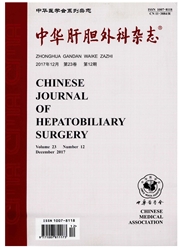

 中文摘要:
中文摘要:
目的评价多模式镇痛在肝癌患者肝动脉化疗栓塞术(TACE)中的有效性及安全性。方法将2016年8月至2016年11月于浙江大学医学院附属第一医院接受TACE治疗的60例肝病患者随机分为多模式镇痛组和对照组。对两组患者术中和术后不同时间点的疼痛和48h镇痛满意度进行评价,比较两组患者药物不良反应发生率及药物经济学差异。结果多模式组在TACE后12h内疼痛控制明显优于对照组,术后即刻、术后2h,4h、6h、12h的疼痛评分均显著低于对照组(P〈0.05);镇痛满意度显著改善(96.6%比66.7%)。多模式组恶心、呕吐等不良反应发生率明显低于对照组(恶心:30%比36.7%;呕吐:20%比33.3%)。药物经济学分析提示多模式组控制TACE疼痛具有更好的疼痛缓解率和成本一效益比。结论多模式镇痛可有效改善TACE术后疼痛,提高疼痛控制满意度,减少药物不良反应,是TACE疼痛控制安全有效且经济的镇痛方法,值得推荐与推广。
 英文摘要:
英文摘要:
Objective To study multimodal analgesia in patients who underwent transarterial chemoembolization (TACE) for hepatocellular carcinoma (HCC). Methods 60 patients who underwent TACE for HCC from Aug. 2016 to Nov. 2016 were randomized into two groups : the multimodal analgesia group and the control group. The pain scores of these two groups of patient during the procedure and at different posttreatment time points, and the rates of adverse effect and pharmacoeconomic differences were recorded. Results When compared to the control group, the pain scores at 0 h, 2 h, 4 h, 6 h, 12 h after treatment in the muhimodal analgesia group were significantly lower ( P 〈 0.05 ) , and the satisfactory scores for the pa- tients were significantly improved (96.6% vs. 66.7% ). The muhimodal group of patients also had signifi- cantly lower adverse effect rates of nausea and vomiting, and it was more cost-effective. Conclusions Patients who required multimodal analgesia had better pain relieve, patient satisfaction and less adverse reactions after TACE than patients in the control group. Multimodal analgesia was a safe, effective and economic way to control TACE pain and it was worth recommended in clinical practice.
 同期刊论文项目
同期刊论文项目
 同项目期刊论文
同项目期刊论文
 期刊信息
期刊信息
